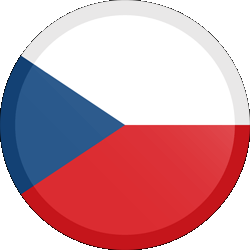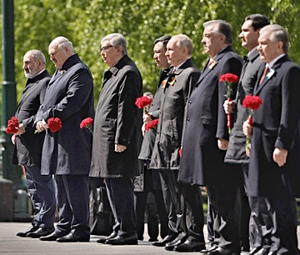„Without Russia, there would have been no war over Nagorno-Karabakh. Russia plays an absolutely crucial role.“
Petra Prochazkova [4]
|
  |
|
|
| Territories newly conquered and occupied militarily by Russia after the collapse of the Soviet Union in 1991.
|
Nagorno-Karabakh War
The 'Nagorno-Karabakh War' was a series of punitive campaigns, massacres, atrocities and forced deportations carried out by Russia on the territory of Azerbaijan and in the border region of Armenia.
Russia's aim was to break both nations' desire for independence and to keep Armenia and Azerbaijan within the 'Russian sphere of influence'. At the same time, Russia was determined to prevent Baku from building a direct oil and gas pipeline through Armenia and Turkey to Western Europe outside Russian-occupied territory.
A film documentary by the office of the president of Russian-occupied Armenia from 2012, which accuses Azerbaijan of genocide in fiery words. Fulfilled by subtitles and commentary.
In doing so, it presents facts that reveal that imperial Russia is the culprit.
download .
|

|
The Nagorno-Karabakh War – chronology in brief.
Occupation and annexation 1920-1921
Lenin's Russia called for the right of nations to self-determination. Despite this, it invaded and occupied Armenia, Azerbaijan and Georgia. Russia eliminated these fledgling democracies and forcibly annexed them into the Bolshevik Soviet Union.
During the invasion, Russia unleashed a bloody massacre in Azerbaijan, killing over 50,000 citizens.
In 1921, Armenia, Azerbaijan, and Georgia became occupied territories of the Russian dominated Soviet Union.
Dissolution of the Soviet Union 1980-1991
The ideology of Marxism-Leninism, forcibly imposed by Russia and elevated to the status of a 'scientific worldview', brought the Soviet Union to its knees. Shops were empty and hunger drove people onto the streets. Protests broke out against poverty and Russian domination.
Russia had long been prepared for the independence aspirations of Armenia, Azerbaijan, Georgia, Chechnya and other Caucasian nations and responded by unleashing terror, massacres, and forced deportations.
Russia began arming violent prisoners and organising terrorist attacks to provoke violence that would create dependence on Russian arms and ammunition supplies.
Invasion and punitive campaign of Russian troops in Azerbaijan - January 1990
In 1989, calls for an end to Moscow's domination of Azerbaijan escalated. Russia thus faced the foreseeable danger of losing control over Azerbaijan and, in particular, its monopoly over Azerbaijan's oil and gas exports. As always, Russia decided to deal with this threat through violence and terror against the population.
Moscow withdrew more than 50,000 troops from military districts in Transcaucasia, Moscow and Leningrad and reinforced them with Russian Interior Ministry troops and other military formations, supplemented by groups of criminals. The war fleet in the Caspian Sea entered the Gulf of Baku.
This army of more than 50,000 men invaded Baku on the night of 19-20 January 1990 and mercilessly shelled the protesting civilian population with all kinds of weapons. According to figures that are still considered inaccurate, 131 people were killed and over 800 injured in this bloodshed.
During the ongoing bloody events in Baku, Moscow sent two motorized infantry divisions to the Iranian border and two "special" divisions to Nagorno-Karabakh.
Curfews were imposed in Baku, Nagorno-Karabakh and Nakhchivan. These bloody events went down in history as "Black January".
In addition to looting, the Russian army confiscated anything that could be used as a weapon, including hunting rifles and even weapons used for military training in schools. The collapsing Russian-Soviet empire committed its far-from-last crimes with extraordinary cruelty.
Armenia's attempt to break free from Russian domination - March 1991
A referendum on the preservation of the Soviet Union was called by Moscow on 17 March 1991. Armenia, along with Georgia, Moldova and the Baltic republics, did not participate.
Operation Kolco - punitive campaign - May to July 1991
For refusing to take part in the referendum, Russia would retaliate with 'Operation Kolco' - the massacre, looting and forced deportation of settlements with predominantly Armenian-speaking populations.
Azerbaijan declares independence - 30th August 1991
- Seeing the atrocities of the Russian army, the troops of the Ministry of Interior, the KGB and the Russian-armed groups of violant criminals, Azerbaijan began to free itself from the Russian domination and to try to expel Russian troops from Azerbaijan.
- On the 30th of August, 1991, Azerbaijan officially left the Soviet Union and declared 71 years of involuntary existence of the 'Azerbaijan Soviet Socialist Republic' as 70 years of Russian occupation (since April 1920).
- On the 14th of September 1991, Azerbaijan abolished the Communist Party of Azerbaijan and introduced direct presidential elections.
- In December 1991, a national referendum approved the declaration of independence from Russia, and Azerbaijan was internationally recognised as an independent state by Turkey, Israel, Romania and Pakistan.
Invasion, deportation and occupation of Azerbaijan 1991 - present
Azerbaijan's efforts to secede from the Soviet Union, which meant Russia's loss of control over the production and transportation of oil and gas from the Caspian Sea region, infuriated Russia. From this point on, Russia redirected all its aggression against Azerbaijan, blaming it for its own atrocities during the Operation Kolco.
The Russian army and the troops of the Russian Ministry of Interior, together with Russian-armed formations of violent criminals, occupied 13.64% of the territory of Azerbaijan in 1991-1994. Agdam, Fuzuli, other towns, and numerous villages in Azerbaijan would be uprooted and destroyed by Russia similar to Bakhmut, Ukraine in 2023.
In the town of Khojaly, a town of eight hundred inhabitants, the 366th motorised artillery regiment of the Russian army, in coordination with formations of violent criminals, would commit a massacre often compared to the extermination of Lidice during the Second World War.
When Russia conquered 13.62% of Azerbaijan under the Armenian flag, it placed the burden of holding the conquered territory on Armenia. By selling vast quantities of arms and ammunition, Russia made Armenia the poorest country in the neighbourhood. Impoverished by Russia and war torn, nearly a million people left Armenia during the following 30 years.
Liberation of part of occupied Azerbaijan 2020
It took three decades for Azerbaijan to build its own army and, in 2020, to partially liberate itself from Russian occupation under the Armenian flag.
Russia still acts under the flag of Armenia, which is still occupied by the Russian army and is completely dependent on Russia economically and militarily. Despite regular electoral frauds, Armenia presents itself to the outside world as a democracy. In Armenian elections, the number of votes often exceeded the number of eligible voters. Thus, Russia always decided the outcome of the elections and who would be a member of the government until 2018.
Basic untruths spread about the so-called 'war on Nagorno-Karabakh'
Lie number 1: It was a war over territorial disputes in Nagorno-Karabakh.
Armenians living in Armenia knew practically nothing about Nagorno-Karabakh. Most did not even know what the name meant. No Nagorno-Karabakh issues were taught in schools nor were they discussed in the media during the Soviet era.
Russia started the war by deploying tanks, armoured vehicles, guns, and helicopters manned by trained Russian soldiers. The Russian army, including Interior Ministry troops, supplemented by armed gangs of violent criminals, massacred the population of all nationalities, regardless of whether they were Armenian, Azerbaijani, or - and predominantly - a mixed family of both nationalities.
The Russian-orchestrated atrocities have been skilfully accompanied by Russian propaganda to deceive the whole world, which has presented the Nagorno-Karabakh war in the media as a local ethnic and religious conflict.
Lie number 2: A war broke out between Armenia and Azerbaijan, which Russia tried to prevent.
Armenia and Azerbaijan could not use guns, tanks, and military helicopters to start a war when neither had an army under the Soviet Union. The only army was the Soviet army, which was controlled by Moscow - that is, Russia. Russia knew full well that both countries would want to get rid of the detested Russian domination (as did Czechoslovakia) and the only way to maintain Russian control of Caspian oil and gas was to provoke a war and make them dependent on Russian supplies of arms and ammunition.
Lie number 3: Nagorno-Karabakh belongs to Armenia because the majority of Armenians live there.
In 1823, according to research by Russian historians, Armenian families made up only 13 per cent of the Nagorno-Karabakh population. By 1897, due to the Russian-sponsored migration of Christians (including Armenians) from the Ottoman Empire and Persia, this figure rose to 53 per cent.
Initially, Armenian and Azerbaijani villages alternated, but during the Soviet era the population mixed through intermarriage, so that by the end of the 20th century there were no ethnically pure Armenian families.
The Armenians living in Armenia themselves did not consider the inhabitants of Nagorno-Karabakh as Armenians, but rather as 'Azerbaijani Turks'.
During the so-called "Nagorno-Karabakh War" of 1988-1994, 750,000 people fled or were forcibly deported to Azerbaijan and only 250,000 went to Armenia. This disproportion shows that the pro-Azerbaijani population must have been three times larger than the pro-Armenian population. To say that the Armenians were the majority seems to be a purposeful lie.
In 2022, Nagorno-Karabakh was home to an indigenous Armenian-Azerbaijani ethnic mix and Armenians who came from Armenia at the end of the 20th century to loot and settle in the houses of the slaughtered and fleeing population. The stay of the Armenian looters was obviously illegal, just like the stay of the Russians who came to loot and live in the Russian-occupied part of Ukraine without Kyiv's permission.
Lie number 4: Stalin committed an injustice when he annexed Nagorno-Karabakh to Azerbaijan.
When Russia divided Transcaucasia into the Azerbaijani SSR, the Armenian SSR and the Georgian SSR in 1936, it was faced with the problem of dividing three regions with mixed Armenian-Azerbaijani populations: Nakhchivan, Zangezur and Nagorno-Karabakh.
Nakhchivan and Nagorno-Karabakh were annexed to the more populous Azerbaijan and Zangezur to the less populous Armenia. Thus, Armenia was substituted for Nagorno-Karabakh with Zangezur, which is still part of Armenia today. It should be noted that dividing an area of mixed population village by village can never be done to everyone's satisfaction.

|
Fig. 1: Prime Minister of Armenia Nikol Pashinyan
with a handful of Russian puppets in Moscow on 9 May 2023.
Source: aranet-en.am
From left: Pashinyan (Armenia), Lukashenko (Belarus)
Tokayev (Kazakhstan), Zhaparov (Kyrgyzstan)
Rahmon (Tajikistan), Putin (Russia) |
Lie number 5: Nagorno-Karabakh is a disputed territory between Armenia and Azerbaijan.
No UN member state, including Russia, has challenged the territorial integrity of Azerbaijan, including Nagorno-Karabakh. Nor has Armenia ever declared that Nagorno-Karabakh is part of it. On the contrary, Armenia has been repeatedly called upon by the international community to vacate the militarily occupied territory of Azerbaijan.
Lie number 6: Russia brokered a ceasefire between Armenia and Azerbaijan in 2020 and sent 'peacekeepers' to Azerbaijan.
Russia started the whole war and kept it going by supplying arms and ammunition to both sides in a way that suited Russian interests.
Azerbaijan, in cooperation with Turkey, regained control of most of its own territory in 2020, and Russia, already preparing to invade Ukraine, could not afford a clash with Azerbaijan and, by extension, Turkey, which controls the entrance to the Black Sea and would cut off Russia's sea route to the part of the Russian army committing crimes in Syria. Russia had no choice but to subtly "sneak out", leaving militarily occupied Armenia to drown in the porridge Russia had cooked.
Calling the Russian army, which loots, destroys, and commits the most heinous crimes in Ukraine, a 'peacemaker' is a truly morbid statement and incomprehensible to any normal thinking person.
Lie number 7: Armenia is a democratic republic.
Lenin`s Russia crushed Armenian democracy in 1920. Since then, Armenia has been an occupied colony of Russia.
Armenia's failure to participate in the referendum on joining the Soviet Union on 17 March 1991 was punished by Russia with bloody massacres, terror, and mass deportations under the Operation Kolco.
There are no free elections in Russian-occupied Armenia; the elections are accompanied by violence, vote-buying and ballot-box stuffing, so that the number of votes cast exceeds the number of eligible voters. An inconvenient candidate runs the risk of assassination. No one but a pro-Russian vassal has been 'elected' until 2018.
The current prime minister, Nikol Pashinyan, who was initially critical of Russia, is nevertheless a vassal of Russia, so much so that he had to attend the celebrations in Moscow on the 9 May 2023 with Lukashenko and a handful of other Russian vassals (see photo right).
Lie number 8: Azerbaijan is an Islamic country.
Islam was brought to the Caucasus region by the Islamic Arabs after they captured the capital of Dagestan, Durban, in 664.
After the Arabs left, Islam was modified by numerous reformers and preachers and gradually departed from the teachings of Muhammad.
Azerbaijan declared a republic on the 28 May 1918, separated the Muslim Church from the state and embarked on the path of de-Islamisation, becoming the first parliamentary democracy in the so-called "Muslim world". Women won the right to vote and the first Western-style university in the so-called "Muslim East" was founded in the capital Baku.
Today's form of Islam in Azerbaijan has virtually nothing in common with Muhammad's Islam except folklore. Atheism is promoted in the country, men and women dress according to Western fashion, and the current attitude of the population towards the faith is as cold as that of the Czechs towards the Catholic Church.
There is no known case of an Azerbaijani shouting "Allahu akbar" committing a terrorist attack.
In this sense, it is an incredible falsity of many Western publicists who, on the one hand, promote Islam, deny Islamic terrorism, and label any critic of Islam as an Islamophobe, or even a Nazi.
On the other hand, they falsely publish the image of Azerbaijan as a despicable Islamic country and give the impression that Russia's massacres and deportations of 250,000 Armenians under the flag of Azerbaijan and 750,000 Azerbaijanis under the flag of Armenia are understandable or even justified.
Lie number 9: The war over Nagorno-Karabakh is a war of Muslims against Christians
If this were the case, it would be impossible for Azerbaijan's main ally to be the traditionally Christian Georgia, which Azerbaijan maintains above-standard friendly relations with.
Armenia and Russia, for their part, have above-average friendly relations with Orthodox Islamic Iran, which supplies Russia with weapons against Ukraine and supports Armenia against Azerbaijan.
Azerbaijan's relations with Iran have long been unfriendly, with Iran keeping an invading army on the border against Azerbaijan and allowing Russia to supply Armenia with arms and ammunition.
Lie number 10: Azerbaijani military aggression triggered exodus of 100,000 ethnic Armenians in September-October 2023
Just as Ukraine, Georgia and Moldova have every right to militarily reassert control over Russian-occupied territory, Azerbaijan has every right to militarily reassert control over Azerbaijani territory, which is recognised by all states of the world. To label Azerbaijan's military action in September 2023 as aggression is as absurd nonsense as labelling Ukraine's defence against Russian occupation as aggression against Russia.
Nagorno-Karabakh (the Republic of Artsakh in Armenian) was mainly inhabited by two groups of people in 2022. Nagorno-Karabakh (the Republic of Artsakh in Armenian) was mainly inhabited by two groups of people in 2022. The first group was the mixed Armenian-Azerbaijani population, who lived in their own houses before 1988. The second, the so-called 'ethnic Armenians' came to the territory of Azerbaijan between 1988 and 1994 to loot and occupy the houses of those inhabitants who had been murdered or driven out by terror saving their lives by fleeing to Azerbaijan.
The first group had no reason to leave, they were just scared by the propaganda of the Russian-installed government in Nagorno-Karabakh. (The then "President of the Republic of Artsakh" Samvel Shahramanyan was a Russian-controlled collaborator - similar to Hitler's Konrad Henlein in the Sudetenland.) This propaganda spread lies about the crimes the Azerbaijani army would commit in the liberated territory. In November 2023, some of these refugees began to return after discovering that none of the predictions of atrocities by the Azerbaijani army had come true.
The other group knew very well that they were living illegally in the homes of the victims of Russian-Armenian crimes, so these so-called ethnic Armenians were fleeing justice in the first place because they were well aware of the crimes they had participated in under the protection and command of Russia.
Many Western journalists revelling in spreading shocking news about the exodus of 'ethnic Armenians' from the imminent massacres by the Azerbaijani army in September and October 2023 have suddenly become silent and none of them dare to write that there were no massacres and that some of the refugees, who committed no crime in the occupied territory, are returning.
References
1.
Waal Thomas De: Černá zahrada. Arménie a Ázerbájdžán v míru a za války. Academia 2012, 1. vydání. ISBN 978-80-200-2072-7.
2.
Обыкновенный геноцид. Операция "Кольцо", весна-лето 1991г. Центр инфoрмации и oбщественных связей аппарата Президента РА 2012. [
Filmový dokument na YouTube.]
3.
Holding Deirdre, Allen Tom: Arménie a Náhorní Karabach. Turistický průvodce. Bradt Travel Guides Ltd. 2019. Nakladatelství JOTA s.r.o, 1. vydání. ISBN 978-80-7565-567-7.
4.
Petra Procházková o konfliktu v Náhorním Karabachu. ČT24 2020. [
Události, komentáře 10.11.2020.]
| © Albastová Zajnap, Muška Karel, 17th December, 2023 |
355 |
